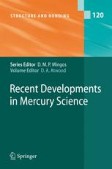Search
Search Results
-
Carbene Complexes of Heme Proteins and Iron Porphyrin Models
The possible formation of carbene complexes of cytochromes P450 enzymes in various metabolisms of xenobiotics is first described. In view of these...
-
Ferrocene–Peptide Bioconjugates
This chapter sketches an outline of ferrocene–peptide bioconjugates. A variety of ferrocene–peptide bioconjugates have been designed to induce...
-
Catalytic Nickel–Iron–Sulfur Clusters: From Minerals to Enzymes
The geochemical theory of the origin of life proposes that primordial, pre-biotic reactions were carried out in a metal-sulfide-rich environment...
-
Sequentially Palladium-Catalyzed Processes
Sequentially palladium-catalyzed reactions consist of combinations of identical, related, or significantly different palladium-catalyzed processes...
-
Structural Aspects of Layered Double Hydroxides
Layered double hydroxides (LDHs) have been known for a considerable time and have been widely studied. The basic features of their structure,...
-
n-Body Decomposition Approach to the Calculation of Interaction Energies of Water Clusters
A new methodology is proposed in which large basis set MP2-level calculations can be extended to water clusters with as many as 50 monomers. The...
-
Multiporphyrin ArraysAssembled Through Hydrogen Bonding
Although relatively weak in isolation, composite H-bonds can be used as an advantage for the assembly of relatively robust and well-defined arrays...
-
Axial Coordination to Metalloporphyrins Leading to Multinuclear Assemblies
The use of axial coordination to metalloporphyrins is discussed on the basis of constructing multinuclear complexes. Starting with single...
-
Poly(mercaptoimidazolyl)borate Complexes of Cadmium and Mercury
The coordination chemistry of bis- and tris(mercaptoimidazolyl)borate ligands with both main-group and transition metals is rapidly expanding....
-
Mercury Removal from Water
Mercury pollution in water is a serious threat to natural ecosystems. Various methods and technologies are in use to remove mercury from the...
-
Intermolecular Interactions via Perturbation Theory: From Diatoms to Biomolecules
This article is devoted to the most recent, i.e. taking place within the last few years, theoretical developments in the field of intermolecular...
-
Rhombohedral PZT Thin Films Prepared by Sputtering
PZT thin films with a rhombohedral perovskite structure were successfully grown on (111) PLT/Pt/Ti/SiO2/Si and (111) Ir/SiO2/Si substrates. The...
-
Correlation Between Domain Structures and Dielectric Properties in Single Crystals of Ferroelectric Solid Solutions
In the present chapter, the growth of single crystals in relaxor–PbTiO3 (PT) solid solution system by the flux method and the solution Bridgman...
-
Relaxor Superlattices: Artificial Control of the Ordered–Disordered State of B-Site Ions in Perovskites
We have developed a new superlattice technique to artificially control the B-site ordering state. The technique has been applied to Ba(Zr0.2Ti0.8)O3,...
-
Pb-Based Ferroelectric Thin Films Prepared by MOCVD
This Chapter focuses on the preparation and ferroelectric properties of Pb-based thin films and nanostructures. First, the growth behavior of...
-
Chemical Solution Depositionof Layer-Structured Ferroelectric Thin Films
Ferroelectric rare-earth-doped Bi4Ti3O12 thin films have been successfully prepared on Si-based substrates by using metallo-organic precursor...
-
Concluding Remarks
So far, the 3DXRD microscope has mainly been applied to fundamental studies in metallurgy. As demonstrated in Chap. 9, the method is sufficiently...
-
The 3DXRD Microscope
The 3DXRD microscope at ESRF is installed in a separate laboratory, the second experimental hutch at beamline ID11 [1,2]. The beamline is an...
-
Applications
An understanding of polycrystalline deformation is essential for science and industry, in order to predict the development of texture and flow stress...
-
Combining 3DXRD and Absorption Contrast Tomography
The 3DXRD setup sketched in Fig. 3.1 is very similar to the setup typically used for absorption contrast x-ray tomography at synchrotrons....
